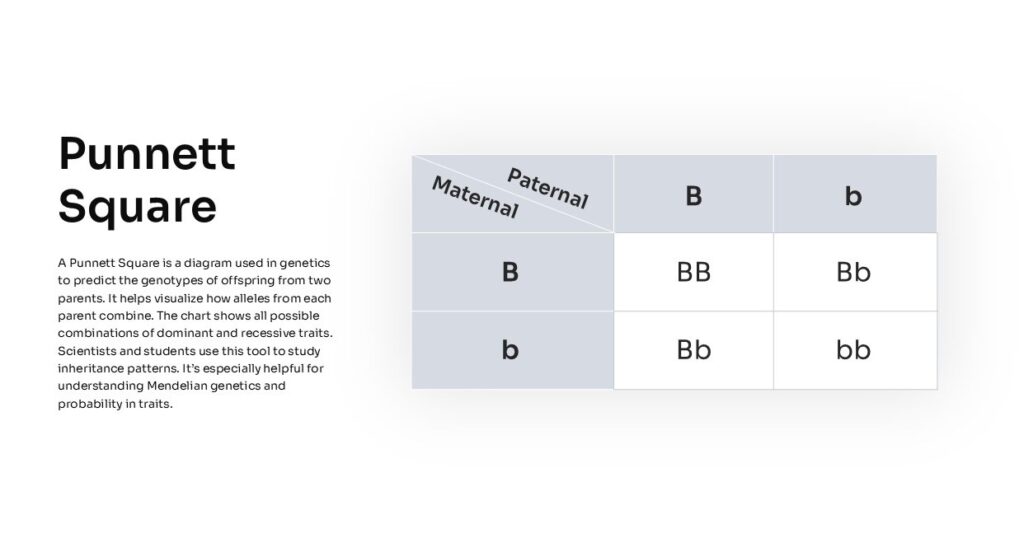A Punnett square is a simple diagram used in genetics to predict the possible genotypes (genetic makeup) and phenotypes (observable traits) of offspring from a cross between two parents with known genotypes.
Here’s how it works and why it’s useful:
- Parental Gametes: You determine the possible gametes (sperm or egg cells) each parent can produce. Gametes carry only one allele for each gene.
- The Grid: You draw a square divided into smaller boxes:
- The rows represent the possible gametes from one parent (usually the mother).
- The columns represent the possible gametes from the other parent (usually the father).
- Combining Alleles: You fill each box in the grid by combining the allele from the row header (mother’s gamete) with the allele from the column header (father’s gamete). This combination represents the potential genotype of one offspring.
- Predicting Outcomes: By looking at the filled grid, you can:
- See all possible genotypes of the offspring.
- Calculate the probability or ratio of each genotype occurring.
- Determine the possible phenotypes (based on which genotypes produce which traits) and their probabilities/ratios.
Example: Pea Plant Flower Color (Simplified Mendelian Trait)
- Alleles:
P(purple – dominant),p(white – recessive) - Cross: Two heterozygous parents (
PpxPp) - Parental Gametes: Each parent can produce
Porpgametes (50% chance each).
Punnett Square:
| P (Dad) | p (Dad) | |
|---|---|---|
| P (Mom) | PP | Pp |
| p (Mom) | Pp | pp |
Interpretation:
- Genotypic Ratio:
PP: 1 box (Top-Left) -> 1/4 (25%)Pp: 2 boxes (Top-Right + Bottom-Left) -> 2/4 = 1/2 (50%)pp: 1 box (Bottom-Right) -> 1/4 (25%)- Ratio = 1 : 2 : 1 (PP : Pp : pp)
- Phenotypic Ratio:
- Purple (PP or Pp): 3 boxes -> 3/4 (75%)
- White (pp): 1 box -> 1/4 (25%)
- Ratio = 3 : 1 (Purple : White)
Key Things to Remember:
- Predicts Probabilities: It shows the chance of each outcome, not the guaranteed result for a small number of offspring.
- Per Gene: A standard Punnett square analyzes the inheritance of one gene/trait at a time. (Dihybrid crosses use a 4×4 grid for two genes).
- Assumes Mendelian Inheritance: It works best for traits controlled by a single gene with dominant/recessive alleles following Mendel’s laws (independent assortment, segregation). Many real-world traits are more complex.
- Tool for Understanding: It’s a foundational tool for learning basic inheritance patterns like dominant/recessive, co-dominance, sex-linkage (though those require modified setups).
Named after: Reginald C. Punnett, a British geneticist who developed it.
